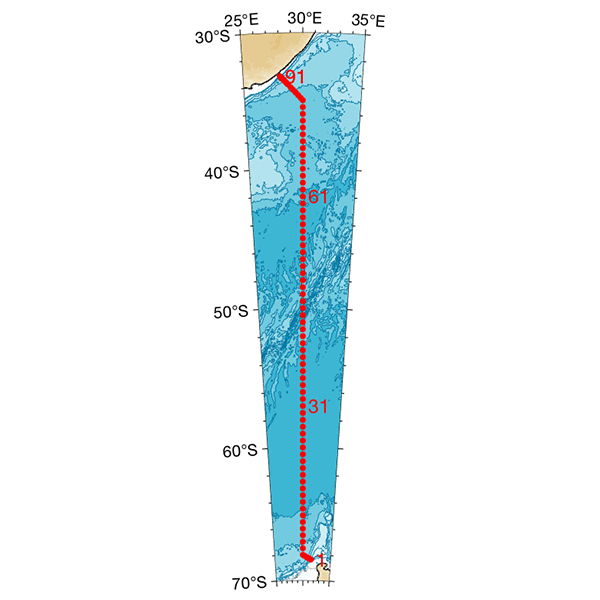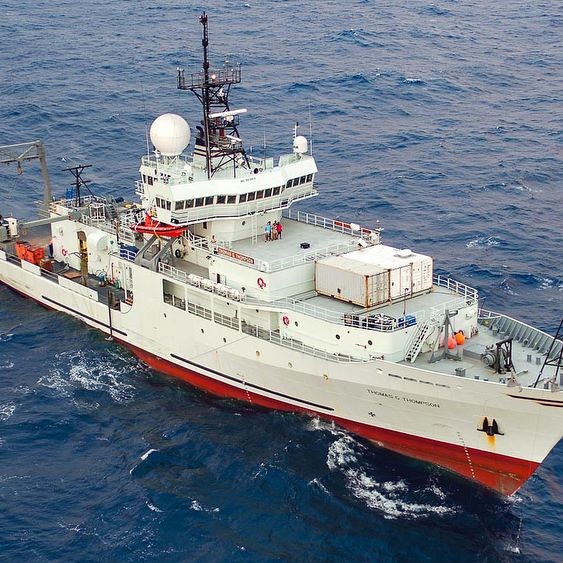Orsi To Serve As Chief Scientist On 40-Day GO-SHIP Antarctic Expedition
From April 3 to May 12, Dr. Alejandro Orsi will lead an international team of scientists aboard the R/V Thomas G. Thompson to re-occupy the I6S line of the Global Ocean Ship-based Hydrographic Investigation Program (GO-SHIP) from South Africa to Antarctica.
Mar 8, 2019

Dark, rough seas and busy days filled with collecting samples from icy waters – “that’s a typical day in the Southern Ocean,” says Dr. Alejandro Orsi, professor in the Department of Oceanography at Texas A&M University.
From April 3 to May 12, Orsi will lead a 40-day oceanography expedition to Antarctica, as the Chief Scientist of the Global Ocean Ship-based Hydrographic Investigation Program (GO-SHIP).
“The overall science goal of the I6S GO-SHIP cruise is to learn how the southwestern portion of the Indian Ocean has changed over the past decades,” said Orsi. “Specifically, GO-SHIP long-term measurements seek to characterize how the deep ocean has warmed and freshened, to determine if the regional budgets of dissolved oxygen and carbon dioxide have changed, and to estimate rates of nutrients depletion and ocean acidification.”
Dr. Isabella Rosso, postdoctoral scholar at Scripps Institution Oceanography, University of California San Diego, is the cruise’s Co-Chief Scientist.

Dr. Alejandro Orsi at the top of Observation Hill, Antarctica, in 2011. (Photo courtesy of Orsi.)

The U.S. GO-SHIP 2019 I6S Cruise logo. (Courtesy of Dr. Alejandro Orsi.)
A total of 27 researchers will be aboard the R/V Thomas G. Thompson, including six students actively working on the cruise. Two of the students are from Texas A&M University: Loicka Baille, undergraduate student in the Department of Ocean Engineering, and Garrett Walsh, graduate student in the Department of Oceanography. Baille will focus on measuring physical parameters, such as operating the CTD (Conductivity-Temperature-Depth) instrument; while Walsh will focus on ocean-atmosphere interactions by measuring gaseous tracers in seawater, such as Chloroflurocarbon (CFC) and Sulfur Hexafluoride (SF6).
Since the 1970s, numerous ship-based hydrographic surveys, such as Geochemical Ocean Section Programs (GEOSECS) and World Ocean Circulation Experiment (WOCE), have been conducted to observe and document the global ocean. However, the lack of formal global organizations and international agreements have progressively diminished the perceived important of repeat transoceanic hydrographic lines to observe the evolution of ocean property budgets in a changing climate. To sustain a global hydrographic program through data sharing, GO-SHIP was established in 2007. By coordinating a network of repeat hydrographic lines across all ocean basins, Go-SHIP brings together scientists with interest in large-scale interdisciplinary climate studies.
GO-SHIP is part of the Global Climate Observing System (GCOS) and Global Ocean Observing System (GOOS), and it is a major contributor to the Climate Variability and Predictability Experiment (CLIVAR) of the World Climate Research Program (WCRP) and the International Ocean Carbon Coordination Project (IOCCP).
For more details on the GO-SHIP program, including upcoming cruises and links to data directory, visit http://www.go-ship.org/.

I6S section along 30°E from South Africa to Antarctica. Red dots indicate the location of the 91 planned hydrographic stations, where profiling and seawater sampling will be conducted. (Figure courtesy of Dr. Alejandro Oris.)

R/V Thomas G. Thompson. (Photo courtesy of GO-SHIP.)
The meridional I6S GO-SHIP hydrographic section that Orsi will lead spans the Indian-Atlantic gateway between Africa and Antarctica (see figure). During this cruise aboard the R/V Thomas G. Thompson it will take about eight full days of sailing, after leaving Cape Town, South Africa on April 3, to reach near the Antarctic shelf break. From there, full water column CTD profiling and seawater sampling will start at stations separated about 30 nautical miles (a unit maritime distance approximately equal to 1,852 m), and continue all the way north along 30°E until arriving back to Cape Town on May 12. I6S 2019 will be the third occupation of the line since the French original in 1996, and the U.S. repeat in 2008.
Once the I6S cruise departures from Capet Town, Texas A&M Oceanography will receive and share exciting narratives and photos from the scientists aboard the R/V Thomas G. Thompson with the public. Stay tuned for updates!
By Bumsoo Kim

